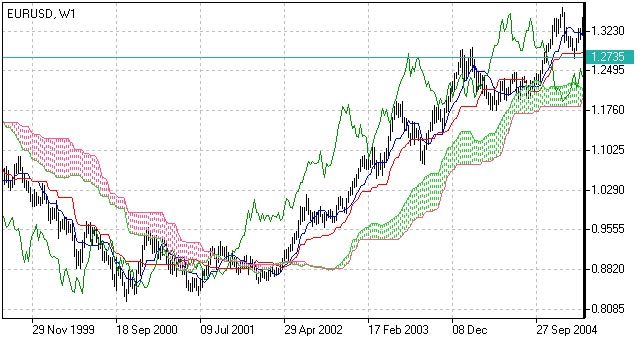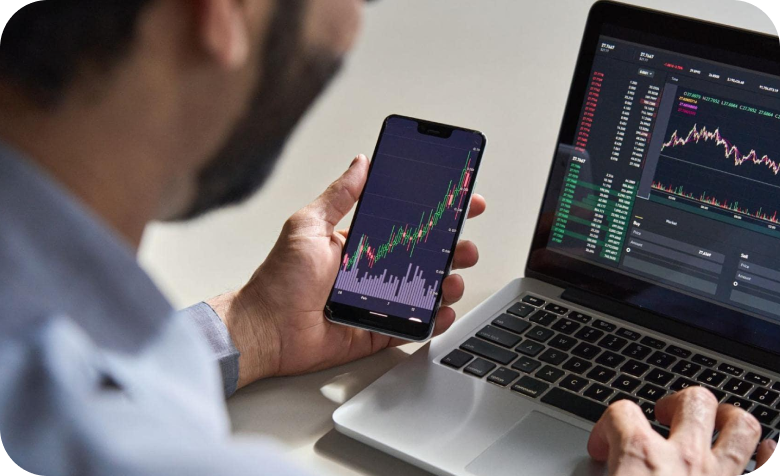- Education
- Forex Technical Analysis
- Technical Indicators
- Oscillators
- Ichimoku Indicator
Ichimoku Indicator - Ichimoku Clouds
What is Ichimoku Kinko Hyo
How to use Ichimoku Indicator in trading platform
How to Use Ichimoku Indicator
The Ichimoku indicator consists of five lines which may all serve as flexible support or resistance lines, whose crossovers may as well be assumed as additional signals:
- Tenkan-Sen (Conversion line, blue)
- Kijun-Sen (Base line, red)
- Senkou Span A (Leading span A, green boundary of the cloud)
- Senkou Span B (Leading span B, red boundary of the cloud)
- Chikou Span (Lagging span, green)
Kumo (Cloud) is a central element of the Ichimoku system and represents support or resistance areas. It is formed by Leading Span A and Leading Span B.
Determining the trend persistence and corrections:
- Price moving above the cloud indicates an uptrend
- Price moving below the cloud indicates a downtrend
- Price moving within the cloud indicates a sideways trend
- Cloud turning from green to red indicates a correction during an uptrend
- Cloud turning from red to green indicates a correction during a downtrend
Determining support and resistance:
- Leading span A serves as a first support line for an uptrend
- Leading span B serves as a second support line for an uptrend
- Leading span A serves as a first resistance line for a downtrend
- Leading span B serves as a second resistance line for a downtrend
Strong Buy/Sell signals occurring above the cloud:
- Conversion line crosses Base line up from below is a signal to buy
- Conversion line crosses Base line down from above is a signal to sell
Less reliable Buy/Sell signals occurring within the cloud:
- Conversion line crosses Base line up from below is a signal to buy
- Conversion line crosses Base line down from above is a signal to sell

Ichimoku Indicator
Ichimoku Trading Strategy
Traders use the Ichimoku strategy to identify the trend. For a bullish signal this trading strategy sets three criteria. First, the trend is bullish when prices reach above the lowest line of the cloud. Second, a bullish signal triggers when prices reverse and reach above the Conversion Line. And third, the trend is bullish when the price moves below the Base Line.
Ichimoku Formula (Ichimoku Kinko Hyo Calculation)
- Tenkan-Sen (Conversion line, blue) is (9-period high + 9-period low)/2
- Kijun-Sen (Base line, red) is (26-period high + 26-period low)/2
- Senkou Span A (Leading span A, green boundary of the cloud) is (Conversion Line + Base Line)/2
- Senkou Span B (Leading span B, red boundary of the cloud) is (52-period high + 52-period low)/2
- Chikou Span (Lagging span, green) is close price plotted 26 periods in the past
Forex Indicators FAQ
What is a Forex Indicator?
Forex technical analysis indicators are regularly used by traders to predict price movements in the Foreign Exchange market and thus increase the likelihood of making money in the Forex market. Forex indicators actually take into account the price and volume of a particular trading instrument for further market forecasting.
What are the Best Technical Indicators?
Technical analysis, which is often included in various trading strategies, cannot be considered separately from technical indicators. Some indicators are rarely used, while others are almost irreplaceable for many traders. We highlighted 5 the most popular technical analysis indicators: Moving average (MA), Exponential moving average (EMA), Stochastic oscillator, Bollinger bands, Moving average convergence divergence (MACD).
How to Use Technical Indicators?
Trading strategies usually require multiple technical analysis indicators to increase forecast accuracy. Lagging technical indicators show past trends, while leading indicators predict upcoming moves. When selecting trading indicators, also consider different types of charting tools, such as volume, momentum, volatility and trend indicators.
Do Indicators Work in Forex?
There are 2 types of indicators: lagging and leading. Lagging indicators base on past movements and market reversals, and are more effective when markets are trending strongly. Leading indicators try to predict the price moves and reversals in the future, they are used commonly in range trading, and since they produce many false signals, they are not suitable for trend trading.
Use indicators after downloading one of the trading platforms, offered by IFC Markets.

Not sure about your Forex skills level?
Take a Test and We Will Help You With The Rest


